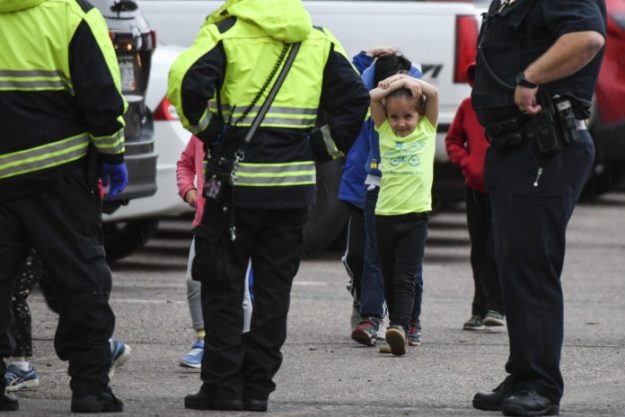Widgetized Section
Go to Admin » Appearance » Widgets » and move Gabfire Widget: Social into that MastheadOverlay zone
Littwin: We are thankful for heroes, but we must ask why any hero must die for going to school

Editor’s note: Mike Littwin’s column runs regularly on The Colorado Independent website.
I hate to admit this, but I take too little comfort in the heroics of Kendrick Castillo, who took down one of the STEM shooters at the cost of his life.
Castillo, a genuine hero, an only child whose father said he wished Kendrick had hidden instead of lunging at the shooter, had only three days of classes left before graduation. For his act of heroism, for his selflessness, for his wish to save others, he was shot and killed. Someone’s child. Someone’s friend. Everyone’s hero and not, apparently, the only hero at STEM.

It breaks my heart, but I don’t need my heart broken. I need — we all need — something more to be done.
We are grateful for people like Castillo, but we must remember, most of all, that he should never have had to die. And a STEM parent should never have had to think, as he told Indy reporter Alex Burness, that the shooting was “inevitable.”
If it was inevitable, it shouldn’t have been. And that’s where we find ourselves. Again. Mourning a brave young man who should be alive and looking forward to a bright future.
Meanwhile appearing on CNN, Nate Holley, a STEM sixth grader standing with his dad, told the story of hiding in the closet with his teacher and classmates, with shooters outside the door. He said he was gripping a metal baseball bat “just in case” because “I was going to go down fighting if I was going to go down.” When asked how old he was, he started to say 12 1/2, then corrected himself to 12. Watch and try not to cry.
This is not the new normal, as some worry. This is the old, familiar, tragic, desperate normal — and has been ever since Columbine or whatever day it was “active shooter” became part of America’s vocabulary. Columbine haunts us still. The Los Angeles Times is running a map of the high-profile shootings in the Denver area. This is how many people see us.
Before the STEM shootings, we were once again in recall season in Colorado for maybe-vulnerable Democrats who voted in the legislature to pass a Red Flag law, which allows a judge to temporarily remove a gun from those presented to the court by police or by family as someone who is a danger to others or to themselves. Sheriffs and commissioners were busily — and absurdly — calling their counties “2nd Amendment Sanctuaries” that wouldn’t enforce the law.
The law is somehow controversial. As DougCo Sheriff Tony Spurlock, who was one of the main supporters of the bill, could tell you, what’s controversial is what happened at STEM. The red flag law wouldn’t have apparently affected the STEM shooting. The police say the shooters, now both identified, were not on their radar.
In any case, the handguns used in the shooting — and there might have been other guns — could not have legally been purchased by either of the shooters. In Colorado, you have to be 21 to own a handgun. You can buy a long gun at age 18. We’ll learn someday how they got the guns. Always, guns.
Anyone who thought officials overreacted when shutting schools down along the Front Range upon learning that a young woman, “infatuated” with Columbine, had flown here from Florida and bought a long gun at a gun store very near Columbine now knows better. We know how that sad story ended. She was in such despair that she killed herself. And when she was found dead in the mountains, far from any school, people admitted they were relieved.
There’s no waiting period in Colorado. Seven days or three days, she might well be alive. The schools wouldn’t have closed. But there is no waiting-period law because we don’t want to inconvenience those purchasing guns. Yes, we have the 2nd Amendment. People, in general, have the right to own and buy guns. There’s nothing in the 2nd Amendment, though, that says there can’t be a waiting period. I know I’m waiting for it to get passed.
This is not just the world we live in. This is the world we choose to live in.
We know still little about the STEM story. We know the names of the two shooters, one an 18 male student, the other a 16-year-old transgender student who identifies as male. We know that Columbine was an aberration and there are virtually never two shooters. We’ll know Friday whether the younger student will be charged as an adult.
For those of us who were around for Columbine, the fact that there were two shooters brings us straight back to that day. It’s different and it’s the same. The combination of shooters is different. The names of the heroes are different.
But the fact that there were heroes is the same. The fact that police stormed the building within minutes is a reflection of the post-Columbine training and, in putting their lives at risk, the police were heroes, too. A private security guard at the school apparently detained one of the shooters.
And then there are the photos of the children, these post-Columbine children lined up at the Rec Center waiting to be reunited with their desperate parents. These children were shocked, but not surprised, by the shootings at their school. After all, they had been doing active-shooter drills since kindergarten.
This is how we raise our children.
So, we point to the heroes. They make us feel better about humanity and about ourselves. We cling to the notion of heroes among villains, who were likely facing mental issues. Or maybe, in the days following the 20th anniversary of Columbine, they were drawn to the disturbed-teen romance of it, until they were caught and captured by the police. Nothing romantic or heroic there.
The thing about the heroes is that they must force us to think about the non-heroes all around us.
The non-heroes are those who look at STEM as they look at other Colorado school shootings, as they remember Aurora and Columbine, and say that this is the best we can do. As in an old Onion headline, “‘No Way to Prevent This,’ Says Only Country Where This Regularly Happens.”
The unthinking, meanwhile, call for teachers to be armed, as if that is an answer. These are people who apparently haven’t looked at any data, like the 2006 study from the Rand Center on Quality Policing, which found that cops involved in a gunfight hit their target — wait for it — 18 percent of the time. That’s police who are trained to be in gunfights. Imagine a teacher engaged in a gunfight shooting across a classroom full of children.
The unheroic include the NRA, whose latest news is of Wayne LaPierre’s battle with Oliver North and LaPierre’s alleged misuse of travel funds. And the unheroic are Dudley Brown and the Rocky Mountain Gun Owners, who are thrilled to threaten legislators with recalls for voting their conscience to try to restrict the gun violence in our state.
As John Hickenlooper tweeted in praise of Kendrick Castillo’s tragic heroics: “This courageous 18 year old lost his life standing up to gun violence — and our federal government can’t even stand up to the NRA.”
If you’re looking for what we can learn from this STEM shooting, in which Castillo was killed and eight others were injured, that’s all you need to know.
Go to The Colorado Independent to read more of Littwin’s work.


